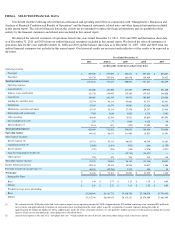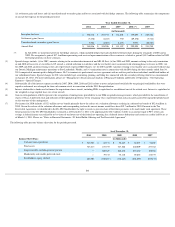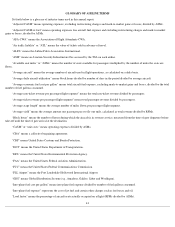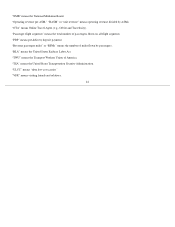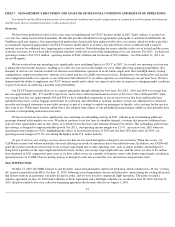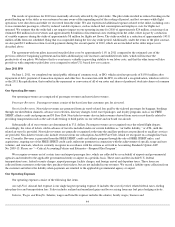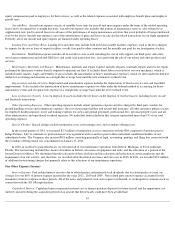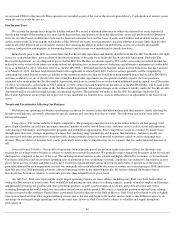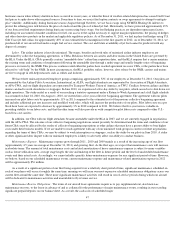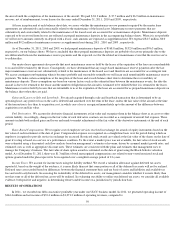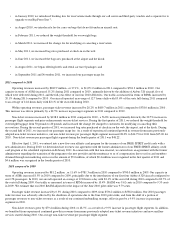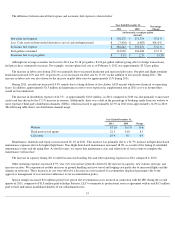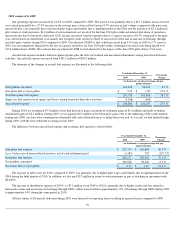Spirit Airlines 2011 Annual Report Download - page 54
Download and view the complete annual report
Please find page 54 of the 2011 Spirit Airlines annual report below. You can navigate through the pages in the report by either clicking on the pages listed below, or by using the keyword search tool below to find specific information within the annual report.
hurricane season when refinery shutdowns have occurred in recent years, or when the threat of weather-
related disruptions has caused Gulf Coast
fuel prices to spike above other regional sources. From time to time, we use jet fuel option contracts or swap agreements to attempt to mitigate
price volatility. Additionally, during hurricane season (August through October), we use basis swaps using NYMEX Heating Oil indexes to
protect the refining price risk between the price of crude oil and the price of refined jet fuel. Historically, we have protected approximately 45%
of our forecasted fuel requirements during hurricane season using basis swaps. Our fuel hedging practices are dependent upon many factors,
including our assessment of market conditions for fuel, our access to the capital necessary to support margin requirements, the pricing of hedges
and other derivative products in the market and applicable regulatory policies. As of December 31, 2011, we had in place fuel hedges using U.S.
Gulf Coast jet fuel collars for approximately 40% of our estimated fuel consumption for the first quarter of 2012. As of December 31, 2011, we
purchased all of our aircraft fuel under a single fuel service contract. The cost and future availability of jet fuel cannot be predicted with any
degree of certainty.
Labor . The airline industry is heavily unionized. The wages, benefits and work rules of unionized airline industry employees are
determined by collective bargaining agreements, or CBAs. Relations between air carriers and labor unions in the United States are governed by
the RLA. Under the RLA, CBAs generally contain “amendable dates” rather than expiration dates, and the RLA requires that a carrier maintain
the existing terms and conditions of employment following the amendable date through a multi-stage and usually lengthy series of bargaining
processes overseen by the NMB. This process continues until either the parties have reached agreement on a new CBA, or the parties have been
released to “self-help” by the NMB. In most circumstances, the RLA prohibits strikes; however, after release by the NMB, carriers and unions
are free to engage in self-help measures such as strikes and lockouts.
We have three union-represented employee groups comprising approximately 52% of our employees at December 31, 2011. Our pilots are
represented by the Airline Pilots Association, International, or ALPA, our flight attendants are represented by Association of Flight Attendants,
or AFA-
CWA, and our flight dispatchers are represented by Transport Workers Union of America, or TWU. Conflicts between airlines and their
unions can lead to work slowdowns or stoppages. In June 2010, we experienced a five-
day strike by our pilots, which caused us to shut down our
flight operations. The strike ended as a result of our reaching a tentative agreement under a Return to Work Agreement and a full flight schedule
was resumed on June 18, 2010. On August 1, 2010, we entered into a five-year collective bargaining agreement. The agreement with our pilots
increased our pilot labor costs by approximately 11% in 2011 compared to the estimated cost of the previous collective bargaining agreement
and includes additional pay rate increases and modified work rules, which will increase the productivity of our pilots. Pilot labor costs on a per
block hour basis are expected to decrease by approximately 3% in 2012 compared to 2011. We believe the five-year term is valuable in
providing stability to our labor costs, and that the other terms will also provide us with competitive pilot labor costs compared to other U.S.-
based low-cost carriers.
In addition, our CBA with our flight attendants became amendable under the RLA in 2007, and we are currently engaged in negotiations
with the AFA-CWA. The outcome of our collective bargaining negotiations cannot presently be determined and the terms and conditions of our
future CBAs may be affected by the results of collective bargaining negotiations at other airlines that may have a greater ability to bear higher
costs under their business models. If we are unable to reach agreement with any of our unionized work groups in current or future negotiations
regarding the terms of their CBAs, we may be subject to work interruptions or stoppages, such as the strike by our pilots in June 2010. A strike
or other significant labor dispute with our unionized employees is likely to adversely affect our ability to conduct business.
Maintenance Expense . Maintenance expense grew through 2011 , 2010 and 2009 mainly as a result of the increasing age of our fleet
(approximately 4.5 years on average at December 31, 2011) and growing fleet. As the fleet ages, we expect that maintenance costs will increase
in absolute terms. The amount of total maintenance costs and related amortization of heavy maintenance expense is subject to many variables
such as future utilization rates, average stage length, the size and makeup of the fleet in future periods and the level of unscheduled maintenance
events and their actual costs. Accordingly, we cannot reliably quantify future maintenance expenses for any significant period of time. However,
we believe, based on our scheduled maintenance events, current maintenance expense and maintenance-related amortization expense in 2012
will be approximately $56 million.
As a result of a significant portion of our fleet being acquired over a relatively short period of time, significant maintenance scheduled on
each of our planes will occur at roughly the same time, meaning we will incur our most expensive scheduled maintenance obligations across our
current fleet around the same time. These more significant maintenance activities will result in out-of-service periods during which our aircraft
will be dedicated to maintenance activities and unavailable to fly revenue service.
Maintenance Reserve Obligations . The terms of our aircraft lease agreements require us to pay supplemental rent, also known as
maintenance reserves, to the lessor in advance of and as collateral for the performance of major maintenance events, resulting in our recording
significant prepaid deposits on our balance sheet. As a result, the cash costs of scheduled major
47


